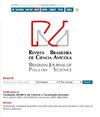同种异体间充质干细胞在牛卵巢内应用的临床安全性
IF 1.1
4区 农林科学
Q3 AGRICULTURE, DAIRY & ANIMAL SCIENCE
引用次数: 0
摘要
生殖生理学的一个基本前提是,雌性的生殖细胞数量有限且不可再生,这导致生殖能力随着时间的推移而下降。对于雌性牛来说,与这种减少有关的另一个因素是卵泡穿刺(取卵- OPU),这是一种广泛用于体外胚胎生产的技术。因此,有必要寻求治疗或预防生育问题的选择,其中一个潜在的选择是使用间充质干细胞(MSC)治疗,它在对抗炎症和退行性过程中发挥副分泌作用。然而,与评估这些治疗的有效性同样重要的是对安全性的评估。在此背景下,本研究将来源于脂肪组织的2.5 × 106同种异体间质干细胞应用于健康的尼洛尔(n = 5)和吉兰多(n = 5)奶牛的卵巢皮层。随后通过超声检查、临床检查、收集的活卵细胞数量和胚胎产生率对动物进行评估。所有动物在接受MSC后均未出现任何临床改变或超声检查改变。此外,应用MSC前后的活卵母细胞数、胚胎产生率和胚胎产生率之间的比较没有显示差异。基于这些数据,可以得出结论,卵巢内应用2.5 x 106脂肪来源的间充质干细胞是安全的,并且该技术代表了作为卵巢变性或病变病例治疗的研究潜力。本文章由计算机程序翻译,如有差异,请以英文原文为准。
Clinical safety of bovine intra-ovarian application of allogeneic mesenchymal stem cells
A basic premise of reproductive physiology is that females have a finite and non-renewable stock of germinative cells, which results in a decrease in reproductive capacity over time. For female bovines, a further factor associated with this decrease is follicular puncture (ovum pickup - OPU), a technique widely used for production of embryos in vitro. As such, it is necessary to seek therapeutic or preventive options for fertility problems, and one potential option is treatment with mesenchymal stem cells (MSC), which exercise a paracrine effect in combating inflammatory and degenerative processes. However, as important as evaluating the efficacy of such treatments is an evaluation of safety. In this context, the current study was carried out with the application of 2.5 x 106 allogenic MSC derived from adipose tissue, to the ovarian cortex of healthy nelore (n = 5) and girolando (n = 5) cows. The animals were subsequently evaluated by ultrasonography, clinical examination, number of viable oocytes collected, and rate of embryo production. None of the animals presented any clinical alteration or any alteration on ultrasonography after receiving the MSC. Furthermore, comparison between the number of viable oocytes, embryos produced, and rate of embryo production before and after MSC application did not show a difference. Based on these data, it can be concluded that intraovarian application of 2.5 x 106 adipose-derived MSC is safe, and this technique represents a potential for study as a therapy in cases of ovarian degeneration or lesions.
求助全文
通过发布文献求助,成功后即可免费获取论文全文。
去求助
来源期刊

Brazilian Journal of Poultry Science
农林科学-奶制品与动物科学
CiteScore
1.80
自引率
9.10%
发文量
60
审稿时长
>12 weeks
期刊介绍:
A Revista Brasileira de Ciência Avícola surgiu em 1999 a partir da necessidade que a comunidade científica possuía de um periódico para veiculação e publicação de seus trabalhos, com a publicação de três números anuais.
A Revista conta hoje com um corpo editorial altamente qualificado e com artigos científicos desenvolvidos pelos maiores especialistas da área, o que a cada dia atrai mais leitores em busca de inovação e respaldo técnico.
Devido à credibilidade que conquistou pelos esforços de sus autores, relatores e revisores, a Revista ganhou caráter de coleção, sendo consultada como fonte segura de estudo desenvolvidos na Avicultura.
A partir de 2003 – volume 5 -, a Revista passou a chamar-se Brazilian Journal of Poultry Science, e todos os trabalhos passaram a ser publicados em inglês. No mesmo ano subiu para quatro o número de revistas por volume, ampliando-se assim os trabalhos publicados anualmente.
 求助内容:
求助内容: 应助结果提醒方式:
应助结果提醒方式:


